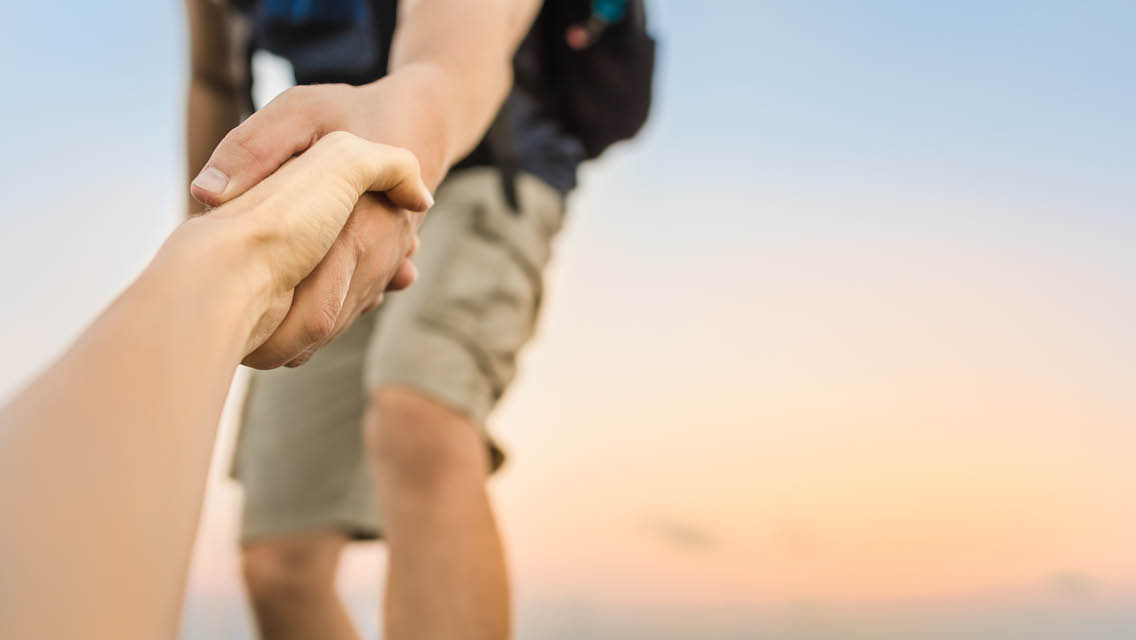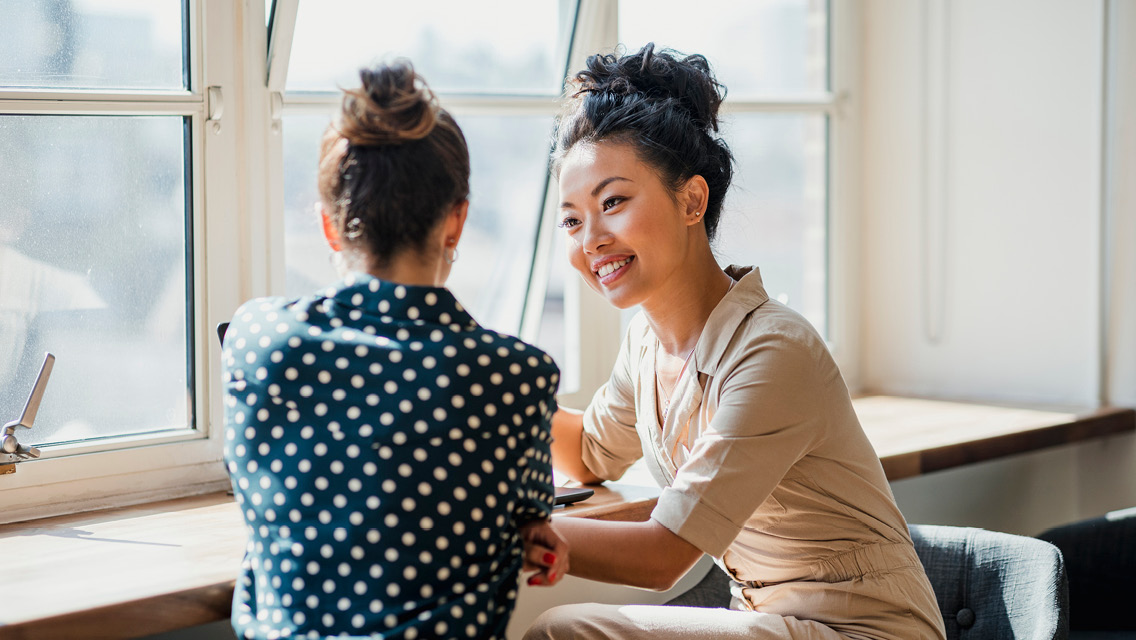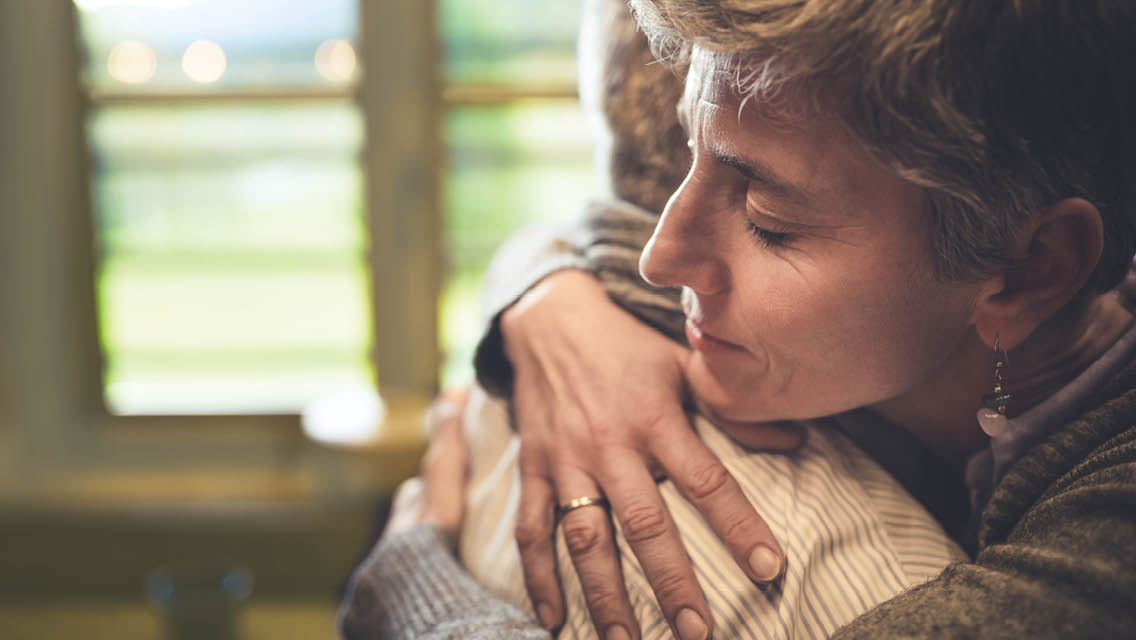We are born to understand each other.
Empathy — the ability to recognize what another person is feeling, and even share that feeling and respond to it — is a survival skill. From early days, empathy has enabled Homo sapiens to discern friend from foe by helping us interpret another’s intent. It prompts mothers to nurture their slowly maturing offspring. It leads groups to cooperate and build communities based on shared vulnerabilities and needs.
“We developed larger eye whites than other primates so we could easily track one another’s gaze, and intricate facial muscles that allowed us to better express emotion,” explains empathy researcher Jamil Zaki, PhD, in The War for Kindness: Building Empathy in a Fractured World. “Our brains developed to give us a more precise understanding of each other’s thoughts and feelings.”
When we see a smile, for example, our facial muscles respond in kind, if only slightly, giving us a visceral sense of what the smiling person feels.
Humans are not the only animals that experience empathy, but we may have the unique ability to choose it. That doesn’t mean we always do.
According to a 2011 meta-analysis, empathy markers in U.S. college students dropped 40 percent over the previous 30 years, with the biggest downturn occurring since the turn of the millennium.
Numerous studies suggest that this trend continues, though most of us need look no further than our own experience: When we feel divided against people in our family or community, indifferent or hostile toward anyone outside our circle, or isolated and numb despite the hyperconnectedness of social media, our empathy might be eroding.
We may even feel skeptical of empathy’s value. In our individualistic culture, we typically don’t learn to view the experiences of others — especially those who seem different from us — as comparable to our own.
And admitting that we are all equally vulnerable to loss and difficulty can feel both unfamiliar and unpleasant. “It’s much harder to allow yourself to be in a vulnerable place and be honest about the reality of life, which is interbeing,” says Laura van Dernoot Lipsky, founder and director of the Trauma Stewardship Institute and author of the books Trauma Stewardship and The Age of Overwhelm.
Meanwhile, many experts believe that our individual well-being is meaningfully improved when we feel more for each other, not less. “Individuals who empathize with others also help themselves: attracting friends more easily, experiencing greater happiness, and suffering less depression than their less empathic peers,” notes Zaki.
Empathy also supports the health of our communities. “To live harmoniously with others, we need empathy,” says meditation teacher Spring Washam, author of A Fierce Heart: Finding Strength, Courage, and Wisdom in Any Moment.
Many experts have explored the reasons behind the apparent decline in fellow feeling; they believe we can reclaim the gifts of empathy — even if we’ve lost our sense of connection or, conversely, we feel overwhelmed by it.
The Age of Disconnection
Humans still live in relationships — in families, friend groups, schools, jobs, neighborhoods, larger communities. But how we relate to each other has changed dramatically in recent decades.
For example, we once socialized primarily in person; now we depend on digital devices for a great percentage of our connections. Communication via text, email, and “snaps” have displaced many in-real-life conversations, along with their shared eye contact and body language — features that help us register the effects of our words on others.
Social media, meanwhile, often has the paradoxical effect of making us antisocial. Algorithm-driven newsfeeds reinforce biases and expose us to a seemingly endless stream of images that suggest that the world is unjust, violent, and divided. We may feel enraged routinely, saying things to strangers online that we never would say in person.
“When empathy evolved, humans were enmeshed in close relationships. We had reason to care about almost everyone we saw,” explains Zaki. “Now we are isolated, stressed, and drowning in animosity. We have more reasons to avoid empathy than ever.”
And avoid it we do. In 2019, researcher Daryl Cameron, PhD, and his students at Penn State’s Empathy and Moral Psychology Lab published a paper on a series of experiments in which people were given the opportunity to choose empathy or not. Study subjects were shown decks of cards featuring photos of people in distress and were given the choice to either describe the person’s physical characteristics or try to imagine and express what that person may have been feeling. Participants opted against empathizing 65 percent of the time.
“We found that empathy for strangers was difficult,” Cameron recalls. “It was cognitively effortful and aversive, and to the degree people felt that way, they avoided empathy more.”
We might also find ourselves avoiding empathy because we’re too good at feeling the feelings of others. When we merge with the emotions of others, losing the distinction between our experience and theirs, empathy can lead to “empathic distress.” This sense of being overwhelmed impedes our capacity to help, and it frequently leads to burning out — or checking out — as a way to protect ourselves. (Are you highly sensitive person? Here are some self-care strategies for you.)
How to Build Your Empathy Skills
Fortunately, we can choose to experience the personal and social benefits that come from connecting to others’ emotions — without numbing out or losing ourselves in the process. These are some practices that can help.
1. Embrace empathy as your birthright.
Empathy is one of our first survival skills. Even as infants, we regulate our emotional state by taking cues from the facial expressions and vocal tones of our caregivers.
Genetics influence how naturally empathic we are, but research shows that our capacity is not fixed. One 2016 study that Zaki contributed to found that empathy is influenced by the company we keep: Participants who perceived that their peers felt high empathy for people suffering in an emotional scenario reported higher feelings of empathy themselves.
In another study with mindset researcher Carol Dweck, PhD, Zaki and his colleagues discovered that participants who learned that empathy is an acquirable skill were more likely to empathize with those who were different from them racially or politically than participants who were primed to believe empathy is a fixed trait.
So, if you’d like to increase your own empathy, spend time with your more empathic friends. If you’re surrounded by folks who tend to put up walls, seek out new connections and experiences that fuel your fellow feeling. Talk to strangers. Volunteer your support for people who need it. Attend a house of worship that’s different from your own.
2. Practice seeing through someone else’s eyes.
Books, films, and other art forms offer an easy, low-to-no-stakes chance to practice empathizing with someone whose life experiences might be totally unfamiliar.
“There is a growing body of evidence confirming that literature, photography, film, and other art forms do indeed have the ability to take us on imaginative journeys into lives that are profoundly unlike our own, and also to inspire empathic acts on the behalf of others once we have put down the novel or left the cinema,” explains empathy researcher Roman Krznaric, PhD, in his book Empathy: Why It Matters, and How to Get It.
Studies suggest that reading literary fiction, in particular, with its emphasis on character development, may measurably increase empathic skills. That includes books such as the Harry Potter series; one 2014 study found that elementary and high school students in the United Kingdom and Italy became more empathic toward refugees, immigrants, and LGBTQ+ people after reading the books, in which themes of unjust discrimination figure prominently.
3. Make new friends.
During the 2016 election season, which was marked by anti-immigrant rhetoric and threats of a Muslim immigration ban, Saadia Qureshi, who is Muslim, began to feel like an outsider in the Florida community where she’d lived most of her life. A chance encounter with an empathic Christian woman at her health club led to a potluck gathering of women from the new friend’s church and Qureshi’s mosque with the specific intent of increasing empathy across groups through conversation and community.
Qureshi’s guests connected over shared concerns about local issues and code-red drills at their children’s schools. They swapped recipes and lingered long after the official end of the gathering. And they have met monthly ever since, sharing their lives, with a level of understanding that would have been impossible without the intentionality of that first gathering.
Qureshi has since turned her passion for building bridges into a full-time job. She now coordinates community gatherings through an international relief and peacemaking organization.
“We develop empathy by listening to each other, doing life together, and sharing each other’s stories,” she says.
Even if we never truly “get” someone, that’s fine. “We think we need to understand every facet of everything, but we don’t,” she adds. “We just have to be compassionate when we show up. We may not understand — and that’s OK.”
4. Make time for real-life conversations.
While the convenience of texting and social media has allowed us to stay connected to others more frequently, there’s just no real substitute for face-to-face conversation. Its abundant social cues help us develop and maintain our empathic skills.
“Without conversation, studies show that we are less empathic, less connected, less creative and fulfilled,” writes MIT researcher Sherry Turkle, PhD, in Reclaiming Conversation: The Power of Talk in a Digital Age.
Although Turkle has lamented the negative effects of social media and digital culture on empathy in her many publications, she believes that we can reclaim our empathic abilities through in-person conversation: “We are resilient. Face-to-face conversation leads to greater self-esteem and an improved ability to deal with others.”
5. Attend to your own suffering.
We may find ourselves tuning out the pain of others because we feel overwhelmed by it. Especially for those working on the front lines of suffering, numbness can be a sign of empathic distress and burnout. “Unless you’re completely disconnected, you cannot be exposed to the suffering of humans, other living beings, and the planet and not have that impact your nervous system,” says Van Dernoot Lipsky.
If you feel overwhelmed or numbed out, she recommends creating systems that will help your nervous system metabolize difficult experiences and emotions so they don’t accumulate. She suggests avoiding excessive exposure to news and social media and recommends regularly checking in with your body and breath, so you can stay present.
She also recommends regular exercise that boosts your heart rate to help “flush” your nervous system.
“We can be compassionate and empathetic, but we don’t have to co-opt other people’s experiences and we don’t have to absorb them,” she explains.
6. Aim for compassion.
Many wisdom traditions teach the importance of transforming empathy into compassion. And compassion, which involves feeling for another — not as them — can also be an antidote to the risk of empathic distress and burnout.
That’s because compassion is inherently energizing. Neurologically, empathy activates the part of the brain that processes emotions, whereas compassion activates the area of the brain associated with reward and motivation.
“When you combine empathy with compassion, then there’s a sense of care,” explains Kristin Neff, PhD, a self-compassion researcher at the University of Texas at Austin. “Those feelings help resource us, rather than drain us.”
What’s more, because we remain motivated, compassion makes it more likely we’ll act on behalf of others. “Empathy is the road to compassion,” says Washam. “It moves us into action.”
Good personal boundaries are key here. When we merge with another person’s pain, we quickly wear ourselves out. But when we hold on to ourselves in the presence of another person’s challenges, maintaining our difference and our connection at the same time, then we can display true compassion. (For more on the importance of boundaries, see “How to Set Clear Boundaries“.)
7. Let go of fixing.
Extending empathy and practicing compassion doesn’t mean we can fix all the suffering we face. What’s more, “fixing” can quickly damage a relationship.
“When our ego takes over and we try to become the savior, then we’re not honoring the people we’re trying to understand,” explains Qureshi. “When you’re in savior mode, then there’s not a connection.”
The impulse to fix is often about our own need for control, rather than the needs of the person we are ostensibly helping. Check to see if you’re trying to micromanage a situation to make yourself feel more comfortable. If so, find a healthy way to soothe yourself before moving ahead.
“This can be hard for parents or healthcare workers,” says Neff. “You think you should be able to fix the other person’s problems, but you can’t. You can try your best, but you can’t control things. That’s where self-compassion and equanimity come in.”
Sometimes the most empathetic, compassionate act is to listen more than talk, and simply sit in uncertainty with another person. “Don’t underestimate the power of a nurse who’s actually present or a schoolteacher who’s actually present,” says Van Dernoot Lipsky. “Showing up with a quality of presence can mean everything in a painful situation, even if you can’t change the outcome.”
8. Accept vulnerability.
Seeing ourselves in another’s plight can be challenging; it means recognizing that their struggle could just as easily be ours. Most of us habitually seek out ways to distance ourselves from others without even knowing we’re doing it.
“When we hear of something sad or awful happening, our brain may go to a place of How am I different from that person?” says Van Dernoot Lipsky. “We think, Oh, it was a drunk-driving accident. I don’t do that.”
One way to get around this is to learn to notice our resistance. Then we might choose to dip a toe into the experience of empathy. We could think, I’ve found myself in an unsafe situation before — I’m fortunate to have come through unharmed, or Just like me, that person wants to be safe and respected.
And there’s always the simple act of silently wishing someone well.
Teaching Empathy to Children
For all the challenges adults have with exercising empathy, children growing up in a largely digital world now have fewer opportunities to practice empathy in face-to-face interactions, which would help them learn through trial and error.
“Kids aren’t seeing and learning how to read facial expressions and cues in the same way,” explains clinical psychologist Christopher Willard, PsyD, author of Growing Up Mindful.
Willard recommends parents and teachers look for everyday opportunities to teach empathy, rather than waiting for an obvious teachable moment. “It’s not just saying, after a kid hits Billy, ‘How do you think that made Billy feel?’”
These strategies can help instill empathy from early on.
- Read aloud to children and point to pictures of characters’ faces. Ask little ones, “How do you think that person feels?” As kids get a bit older, ask, “Why might this person have acted this way?”
- Play games. Simple games like 20 Questions, I Spy, and charade-type games teach empathy and emotional intelligence. “They make kids think, What could Dad be thinking about? He usually picks an animal,” says Willard. Or they look where you’re looking to see what you might spy, getting a sense of your actual perspective in that moment.
- Model empathy. Willard recalls a recent New Year’s Eve when his young family used Monopoly money to help the kids understand and participate in decisions about where to donate money to support causes they cared about.
- Ask older kids to write first-person stories from another person’s perspective. Reading narratives of people who have experiences that are different from ours also goes a long way toward sparking empathy. This is a skill adults can practice, too.





This Post Has 0 Comments